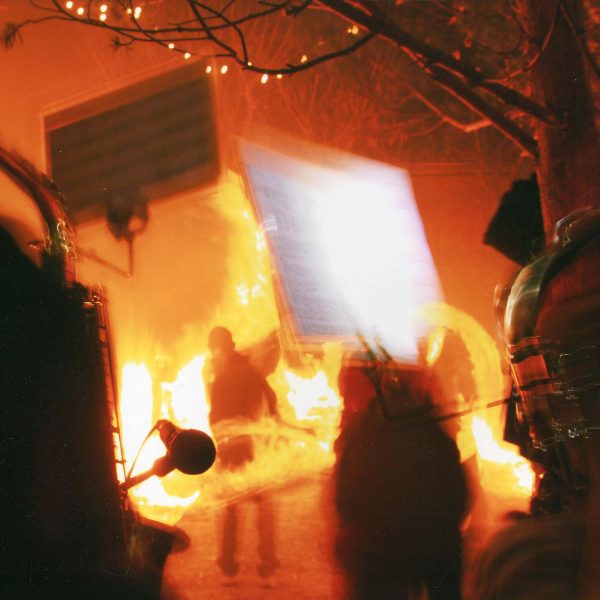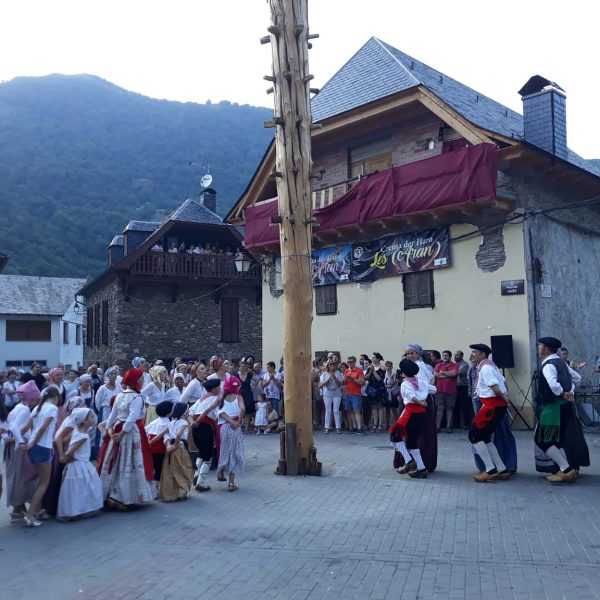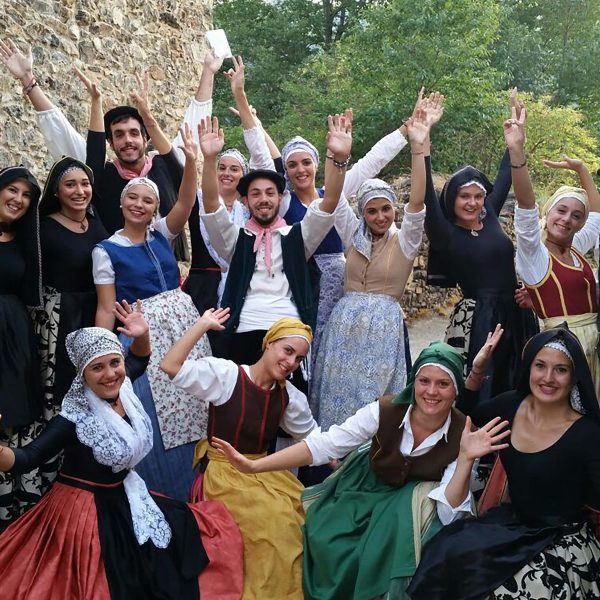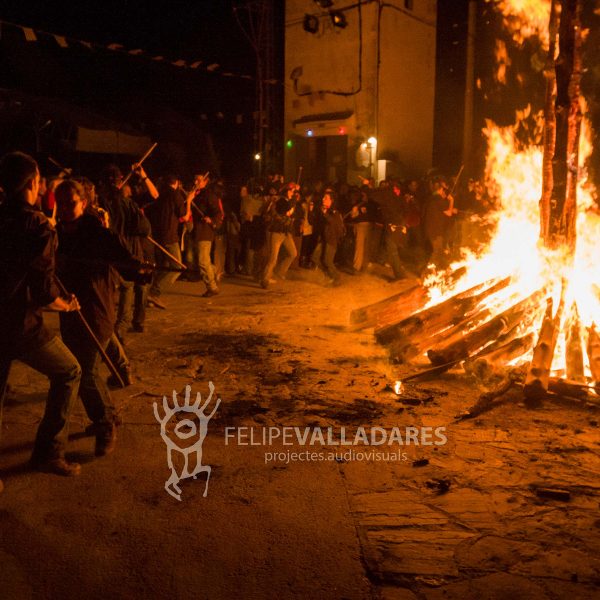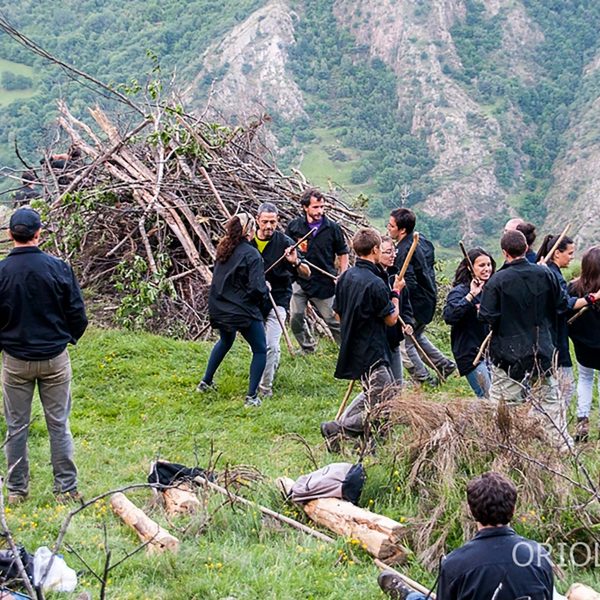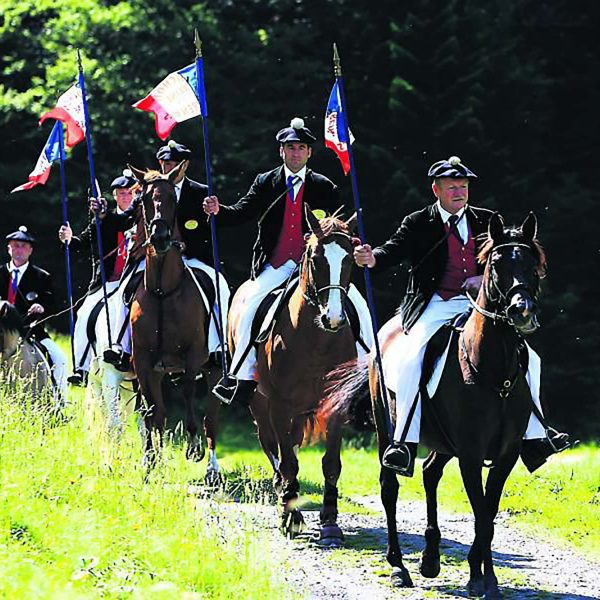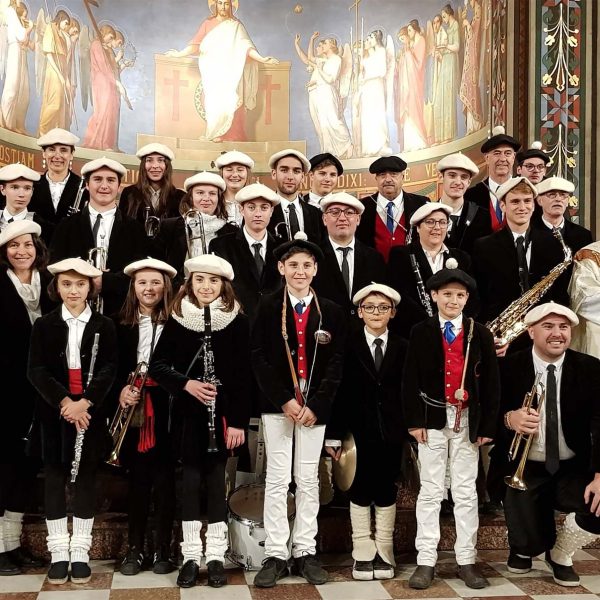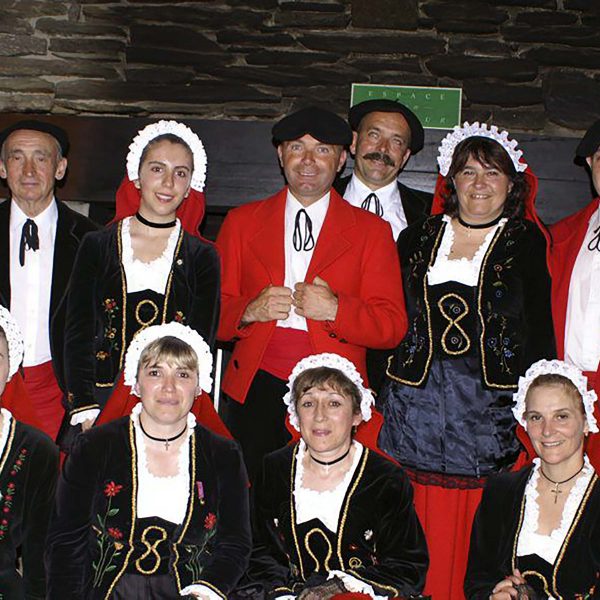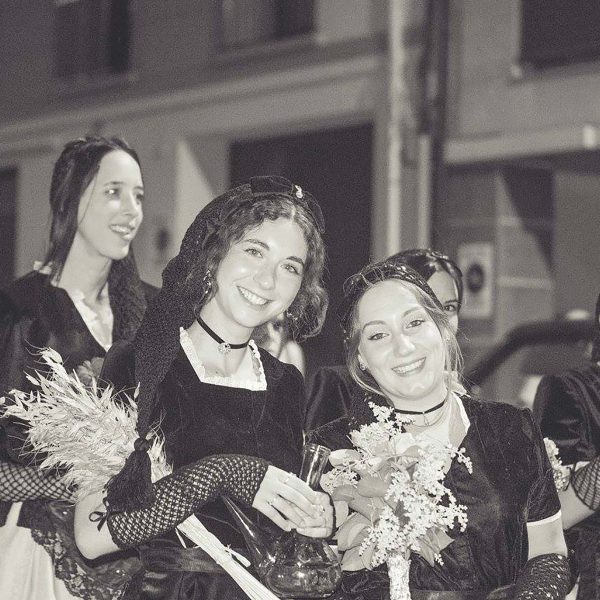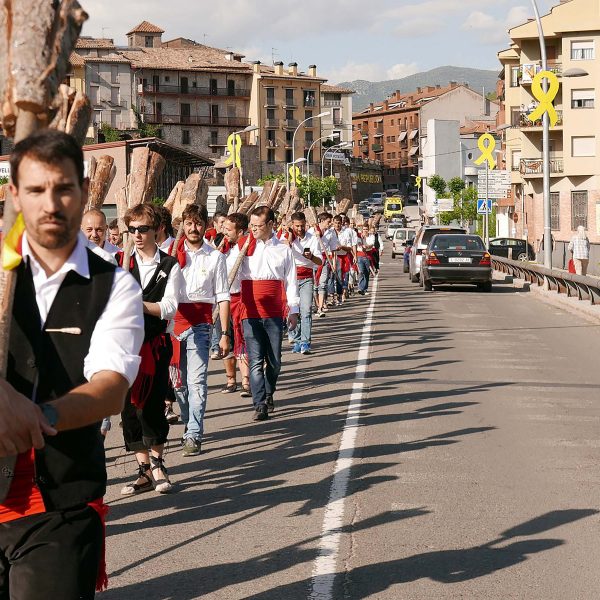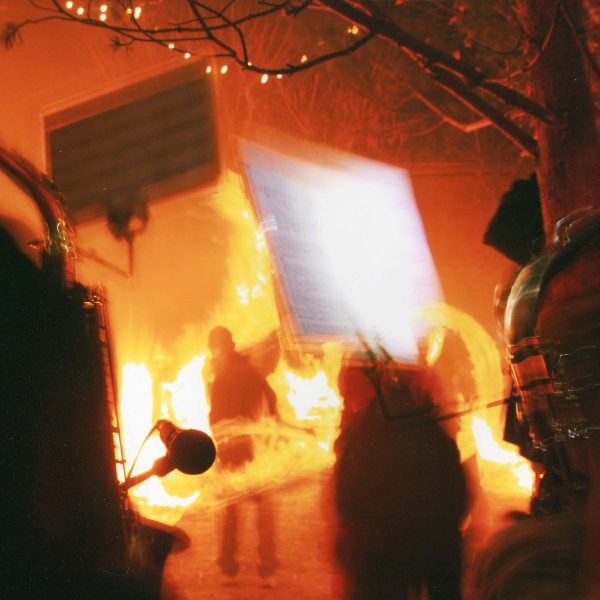Music and dancing, both traditional and modern, are essential components of the festivals. While in some villages (Les, Bagnères-de-Luchon, Andorra, Bagà, Sant Julià de Cerdanyola, Isil, and La Pobla de Segur) there are traditional dances associated with the festival, in others the burning of the falles is followed by dancing to a band playing popular hits.
In all the villages, the festivities continue with a band playing popular hits until the early hours. With the euphoria prompted by the fire rituals, the celebrations continue with dancing and revelry, an essential part of the solstice celebrations, one that has a therapeutic function for the whole community.
The Corbilhuèrs in Les
In Les, members of the Corbilhuèrs group perform typical Aranese dances around the haro:
– The Cadrilh is a ceremonial dance that is suitable for festivals and important celebrations. It dates from the 19th century, but was choreographed in the fifties. As its name indicates, groups of four perform various different arrangements, chains, and circles, etc. that are accompanied by singing.
– The Carrilhon is a Béarnaise dance that has been choreographed by the Corbilhuèrs. The words were written by the singers.
– The Ball-Pla is originally from the village of Canejan and was danced for the annual village festival. The words are traditional, but there are two stanzas that were composed by the Corbilhuèrs.
– The Aubada is one the most traditional dances in the Aran Valley and was first danced in the 19th century in all the villages in the area.
– The Tricotèr, the so-called knitting dance, is a real festival dance, danced in Canejan on Carnival Day by the young people in the village. Dancers knit and unpick various different figures as they dance their way through the village streets.
– The Barricot deth nòvi refers to the wedding meal.
The Corbilhuèrs group wear two types of costumes: typical Gascon country clothes, or the festival costume. The first, which is worn on Saint John’s Eve, consists of a long, felt skirt, petticoat, pantaloons and apron, a white blouse and a corset, with a headscarf and a straw hat (for women). On their feet they wear clogs or sandals and woolen socks. The men wear trousers, a felt waistcoat, a linen shirt, a red sash, and a hat. They also wear clogs.
This group has worked hard to revive local traditional instruments, which include the diatonic accordion, the cornamusa (eth bot) and the three-hole recorder
Traditional dances at the Isil falles
Although falles have never been cancelled in Isil, the dances were discontinued for many years. However, a news item dated July 10, 1902 in La Veu de Catalunya stated that the Ball Pla (Flat Dance) was performed in solemn manner on three days: during the festivities itself, on the 24th in the morning, and on the 25thin the afternoon. It is not clear when the dances were lost, but it seems that they continued through the post-war period and were still being danced as late as 1957, according to Pere Català Roca, who visited that year.
In 1978, Jaume Arnella and Dolors Llopart set out to revive the music on the basis of conversations with older village residents. The dances were resumed in 1993 thanks to the initiative of the Consell Cultural de les Valls d’Àneu and the annual Dansàneu festival. Since then, the Isil falla dances have been performed around the falla major every Saint John’s Eve.
- The musicians begin with the Marxa dels fallaires (March of the Fallaires). Danced in pairs, it can only be danced by those who have brought down a falla from the beacon. The dance is performed with the hazel poles that have been used to support the falla on the way down. The musicians play the tune four times over, with the fallaires facing their partner as they dance around the falla major in an anticlockwise direction.
- The Marxa dels fallaires is followed by the Ball de Bastons (stick dance), whose tune is similar to L’Hereu Riera. In this dance, groups of three fallaires dance around and over the poles, which are laid crosswise on the ground.
- The Ball pla (Flat Dance) is led by the leaders of the dance, who set the rhythm and are joined by the rest of the villagers, who also sing the song. In this dance, in which the village girls join the fallaires, the poles are no longer needed and are thrown onto the fire.
- The last of the dances to be performed is La Bolangera, which is also sung. It is danced initially by the women, who then invite the men to dance as indicated by the words of the song: first the locals, then those from the valley, and, finally, outsiders. The musicians keep playing until the dancers leave the square. So many people have joined in around the fire in recent years that it is difficult to dance well. The dance is repeated numerous times and the musicians can’t be expected to keep playing till the next day, so the leader of the dance leads the fallaires out of the square. They don’t always manage to do this, but the musicians stop playing when they see that the dance leader has left the square.
You can listen to the music here :
La Marxa dels Fallaires
El Ball de Bastons
El Ball Pla
La Bolangera
Music in Luishòn
Several different local groups play a part in celebrating the brandon:
–La Fanfàrria Municipal, which was founded in 1875 has always participated in Bagnères-de-Luchon festivities, parades through the main streets of the town in traditional costume and is accompanied by all the folk groups in the area.
–The Grup Folklòric Fils de Luchon dates back to December 1934. This traditional dancing and singing group now has 35 members. For each performance, the singers wear Pyrenean shepherds’ costumes: a black velvet jacket and trousers, a white woolen cape, wide red belt, and long woolen socks. They carry a holly stick.
The male dancers wear a small red wool bolero, black trousers, long woolen socks with black laces, and black leather pumps. Like the singers, the dancers also wear a black lace tie over a white shirt. The women wear a hood, a red woolen dress, and a black velvet corset embroidered with flowers. They wear gloves and black pumps like the men.
–La Quadrille Luchonnais, which was created in 1991, aims to revive the glory years of traditional dance.
–La Compagnie des Guides à Cheval was founded more than 250 years ago
Music in Pobla de Segur
When the fallaires and pubilles arrive at the Pedrera square, the fallaires make a bonfire with their falles. Afterwards, fallaires, pubilles, and anyone who wants to join in all dance the traditional sardana of La Pobla de Segur entitled Als peus del Pirineu (At the foot of the Pyrenees).
This sardana dates back to 1967, when La Pobla de Segur was designated “Ciudad pubilla de la Sardana”, a prestigious award. As a result of the award, sisters Assumpció and Montserrat Rocafort i Pons composed the sardana Als peus del Pirineu, which they dedicated to their town.
Over time, this piece has become the town song. Currently, the Sardana de la Pobla, as it is popularly known, is played at many of the festive events of the town, like the falles festival. It is also always sung for the Caramelles fiesta. The Orfeó Lleidatà recorded this sardana for the first time in 1967.
Here is a part of the sardana :
Com joia meravellosa
als peus del bell Pirineu,
somriu la nostra Pobla
somriu, mirant al cel.
(Like a wondrous jewel,
At the foot of the beautiful Pyrenees
Our Pobla smiles,
Smiles at the sky)
Dolcissims cants la veu entona,
sembla que clamin precs damor;
ballant contents eixa sardana
deixarà a tots un gran record.
(Voices sing the sweetest of songs
That seem to be requests for love
We happily dance this sardana
Which will be remembered fondly by all)
Tot celebrant eixa diada
saltironem amb il·lusió.
Tralarà larà larala.
tralarà larà larala;
tot ballant eixa sardana
la festa salegrarà.
(To celebrate this day
We skip and jump with joy)
Tralarà larà larala.
tralarà larà larala;
We celebrate this festival
By dancing this sardana)
Tralarà larà larala.
tralarà larà larala;
veniu tots a festejar-la,
i tots junts dem-nos les mà.
(Tralarà larà larala.
tralarà larà larala;
Come to celebrate
Let’s join hands one and all)
Listen to the Sardana and see the full song here:
Als Peus del Pirineu
La Sardana de la Pobla
La fia faia
The fia faia song is one of the main components of the Bagà and Sant Julià de Cerdanyola falles. The music starts when the faies are lit and continues until they have arrived at the square in front of the village hall. The song is also sung in the porticoed square later, with dancing around the fire.
The dance consists of 6 phrases of 8 bars. The dance is performed around the fire, with dancers holding hands and with their feet together. Music: Neus Salvador.
The words are as follows :
La crida
Fia-Faia, Fia-Faia,
que nostre Senyor
ha nascut a la palla! (bis)
The call
(Fia-Faia, Fia-Faia,
Our Lord
Was laid in a manger (literally, born in the straw))
El ball
Fia-Faia, Fia-Faia,
que nostre Senyor
ha nascut a la palla! (bis)
Fia-Faia, Fia-Faia,
que nostre Senyor
ha nascut a la palla! (bis)
Ballem al voltant del foc, foc que ens il·lumina,
en la nit més llarga de l’any, en la nit més divina.
Foc crema foc, (bis) crema la fia-faia,
foc crema foc, (bis)
Jesús ha nascut a la palla.
Foc crema foc, (bis) crema la fia-faia,
foc crema foc, (bis)
Jesús ha nascut a la palla.
The dance
(Fia-Faia, Fia-Faia,
Our Lord
Was laid in the manger (bis)
Fia-Faia, Fia-Faia,
Our Lord was laid in a manger (bis)
Let’s dance around the fire, fire that gives us light
On the longest night of the year, the most holy night
Fire, burn fire, (bis) burn the fia-faia
Fire, burn fire, (bis)
Jesus was laid in the manger
Fire, burn fire, (bis) burn the fia-faia
Fire, burn fire, (bis)
Jesus was laid in the manger)
 Occitan
Occitan




